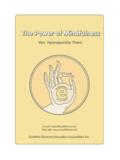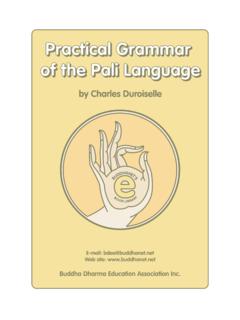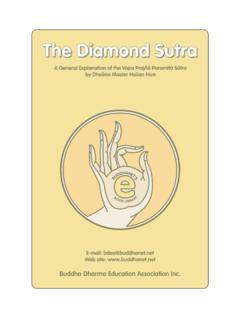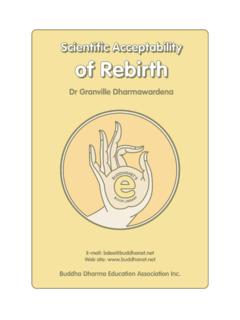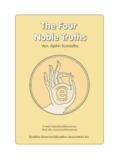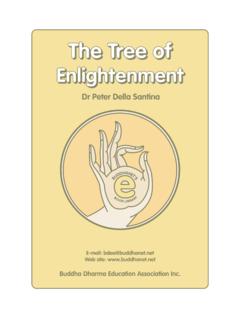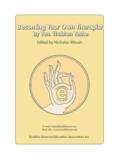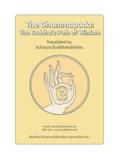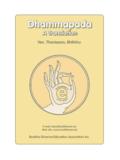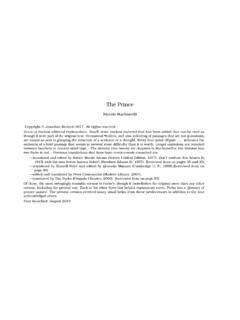Transcription of Buddha's Tales for Young and Old Prince Goodspeaker -Vol. 1
1 EBUDDHANET'SBOOKLIBRARYE-mail: site: Dharma Education Association by Ven. Kurunegoda PiyatissaStories told by Todd AndersonBuddha's Tales for Young and OldPrince Goodspeaker - Vol. 1 Buddha's Tales for Young and OldPrince Goodspeaker - Vol. 1 iiPrince Goodspeaker Contents Interpreter s Introduction From The Storyteller To The Reader 1. Demons In The Desert [The Correct Way Of Thinking] 2. Finding A New Spring [Perseverance] 3. The Golden Plate [Greed And Honesty] 4. The Mouse Merchant [Diligence And Gratitude] 5. The Price Maker [Foolishness] 6. Prince Goodspeaker And The Water Demon [Chapter 1. Rebirth Of The Bodhisatta] [Chapter 2. The Teaching Of The Gods] 7. Little Prince No-father [The Power Of Truth] 8, 462.
2 The One-hundredth Prince [Obedience To A Wise Teacher] 9. The King With One Gray Hair [Ordination] 10. The Happy Monk [Joys Of The Spiritual Life] 11. Beauty And Gray [A Wise Leader] I VII 1 6 9 13 18 22 24 32 37 42 46 51 iii 12. King Banyan Deer [Chapter 1. Compassion] [Chapter 2. Teaching] 13. Mountain Buck And Village Doe [Infatuation] 14. The Wind-deer And The Honey-grass [The Craving For Taste] 15. The Fawn Who Played Hooky [Truancy] 16. The Fawn Who Played Dead [Attendance] 17. The Wind And The Moon [Friendship] 18. The Goat Who Saved The Priest [Ignorance] 19. The God In The Banyan Tree [A Bad Promise] 20. The Monkey King And The Water Demon [Attentiveness] 21. The Tree That Acted Like A Hunter [Impatience] 22.
3 The Dog King Silver [Justice] 23, 24. The Great Horse Knowing-one [Courage] 25. Dirty Bath Water [Cleanliness] 55 61 64 69 73 75 79 81 85 87 91 94 101 108 iv 26. Ladyface [Association] 27. Best Friends [The Power Of Friendship] 28, 88. The Bull Called Delightful [All Deserve Respect] 29. Grandma s Blackie [Loving-kindness] 30, 286. Big Red, Little Red And No-squeal [Envy] 31. The Heaven Of 33 [Chapter 1. Co-operation] [Chapter 2. Compassion] [Chapter 3. Merit] 32. The Dancing Peacock [Pride And Modesty] 33. The Quail King And The Hunter [Unity] 34, 216. The Fortunate Fish [Desire] 35. The Baby Quail Who Could Not Fly Away [The Power Of Truth, Wholesomeness And Compassion] 36. Wise Birds And Foolish Birds [Good Advice] 37.
4 The Birth Of A Banyan Tree [Respect For Elders] 111 115 120 125 129 131 138 140 144 147 151 154 157 159 v38. The Crane And The Crab [Trickery] 39. Buried Treasure [The Arrogance Of Power] 40. The Silent Buddha [Generosity] 41, 82, 104, 369, 439. The Curse Of Mittavinda [Chapter 1. Jealousy] [Chapter 2. Greed] [Chapter 3. Pleasure] 42, 274, 375. The Pigeon And The Crow [The Danger Of Greed] 43. Bamboo s Father [Wasted Advice] 44, 45. Two Stupid Children [Foolishness] 46, 268 Watering The Garden [Foolishness] 47. Salty Liquor [Foolishness] 48. The Magic Priest And The Kidnapper Gang [Power And Greed] 49. The Groom Who Lost His Bride To The Stars [Astrology] 50. The Prince Who Had A Plan [The Power Of Superstition] Appendix A.
5 Who Was the Bodhisatta? Appendix B. An Arrangement of Morals 162 169 172 177 185 190 197 203 206 209 212 214 221 224 229 231 IInterpreter s Introduction It is a pleasure to rewrite the Jataka stories in modern English understandable by western readers. To achieve this goal, the stories are being retold in order to convey the spirit and meaning. They are not scholarly word-for-word translations as have been done by others. The Pali Text So-ciety has published the whole text in English translations a hundred years ago. In Sri Lanka they were translated into Sinhalese in the 14th century, where they were known as Pansiya Panas Jataka. In all Buddhist countries the Jataka Tales were the ma-jor sources for developing the character of the people.
6 They were used widely in preaching by monks and lay preach-ers. King Dutugemunu (2nd century ), in Anurad-hapura, paid for the support of preachers to teach Dhamma, the teachings of the Buddha. They usually used these sto-ries in their sermons. Even the Venerable Arahant Maha Mahinda, who introduced Dhamma into Sri Lanka, used these stories to illustrate the truth of the teachings. Some were even used by the Lord Buddha in his teachings, and from him his followers learned them and passed them into popular use in society. Even earlier, the same types of sto-ries were present in Vedic literature. Greek myths, as well as the fables of Aesop, inherited them from the Vedas and Buddhism; Persia also took them from India.
7 They later migrated into the stories of Chaucer in England and Boccaccio in Italy. The stories were used IIfor a variety of purposes. In Sanskrit, the Pancatantra used them to teach Law and Economics, and the Katha Sarit Sa-gara used them for the development of knowledge, as well as just for enjoyment. In the past, people have been satis-fied and fulfilled in many ways by hearing them in forms ranging from lessons to fairy Tales . By reading these stories, children and adults can de-velop their knowledge and learn how to face the difficult experiences of modern life. They can easily develop human values and good qualities like patience, forbearance, toler-ance and the four sublime states of mind loving-kindness, compassion, sympathetic joy and equanimity.
8 The major purpose of these stories is to develop the moral and ethical values of the readers. Without them, people cannot be peaceful and happy in their hearts and minds. And the reader will find that these values are very different from those of the wider, violently acquisitive, ego-based society. In this interpretation, changes are being made to the style of the old Jataka stories, and explanations are added, as is appropriate for children in the modern world. The lovely artwork is also sometim es in a modern setting, to at-tract Young and old to the truths contained in the Tales . The sources used have been as follows: 1. Jataka Pali (Colombo: Buddha Jayanti Tripitaka Se-ries Publication Board, 1983) original Pali stanzas.
9 2. Jataka Pali (Colombo: Simon Hewavitarane Be-quest, 1926) original Pali Jataka stories in Sinhalese characters. III3. Sinhala Jataka Pot Vahanse (Colombo: Jinalankara Press, 1928) Sinhalese translation of Pali Jataka stories. 4. Sinhala Jataka Pot Vahanse, (Colombo: Ratnakara Bookshop, 1961) Sinhalese translation of Pali Jataka stories. 5. Jataka Pota, ed. Lionel Lokuliyana (Colombo: M. D. Gunasena & Co., 1960) Sinhalese translation of first fifty Pali Jataka stories. 6. The Jataka or Stories of the Buddha s Former Lives, ed. E. B. Cowell (London: Pali Text Society, 1981), 6 vols., index English translation of Pali Jataka stories. 7. Pansiyapanas Jataka Pot Vahanse (Bandaragama: N. Prematilaka, 1987) Sinhalese summaries of Pali Jataka stories.
10 In addition, From the Storyteller to the Listeners (be-low), contains a paraphrase taken from Discourse With Canki, Middle Length Sayings (Majjhima-Nikaya), trans. I. B. Horner (London: Pali Text Society, 1975), 11, 95, pp. 362-3. The title of the fourth story, The Mouse Merchant , was originally in Somadeva, The Ocean of Story (Katha Sarit Sagara), trans. C. H. Tawney (London: C. J. Sawyer, 1924). The sequence numbers used for the stories are in the same order as in the Jataka Pali and The Jataka or Stories of the Buddha s Former Lives (above). Multiple sequence numbers indicate that identical, similar or partial stories are told in one version.
